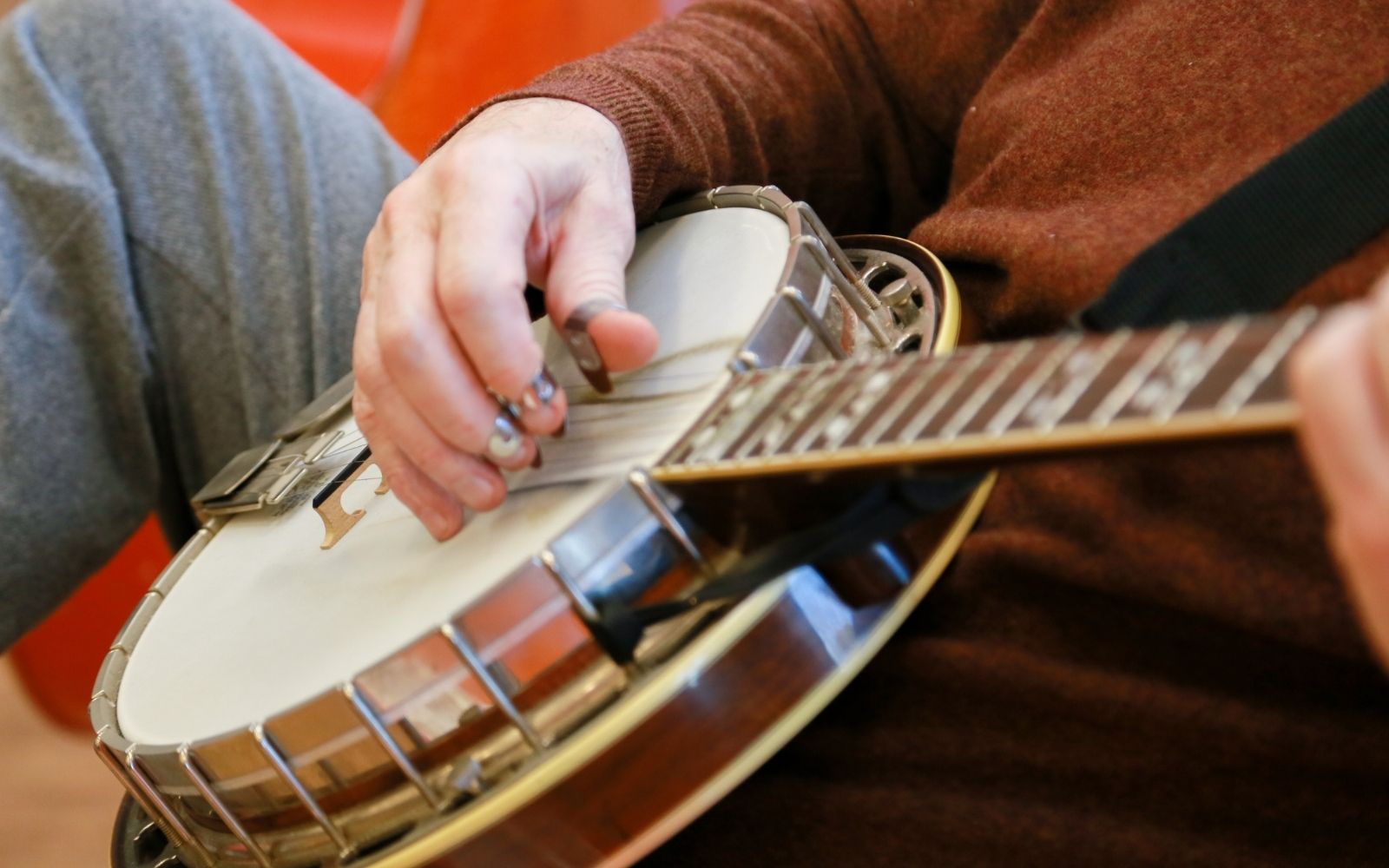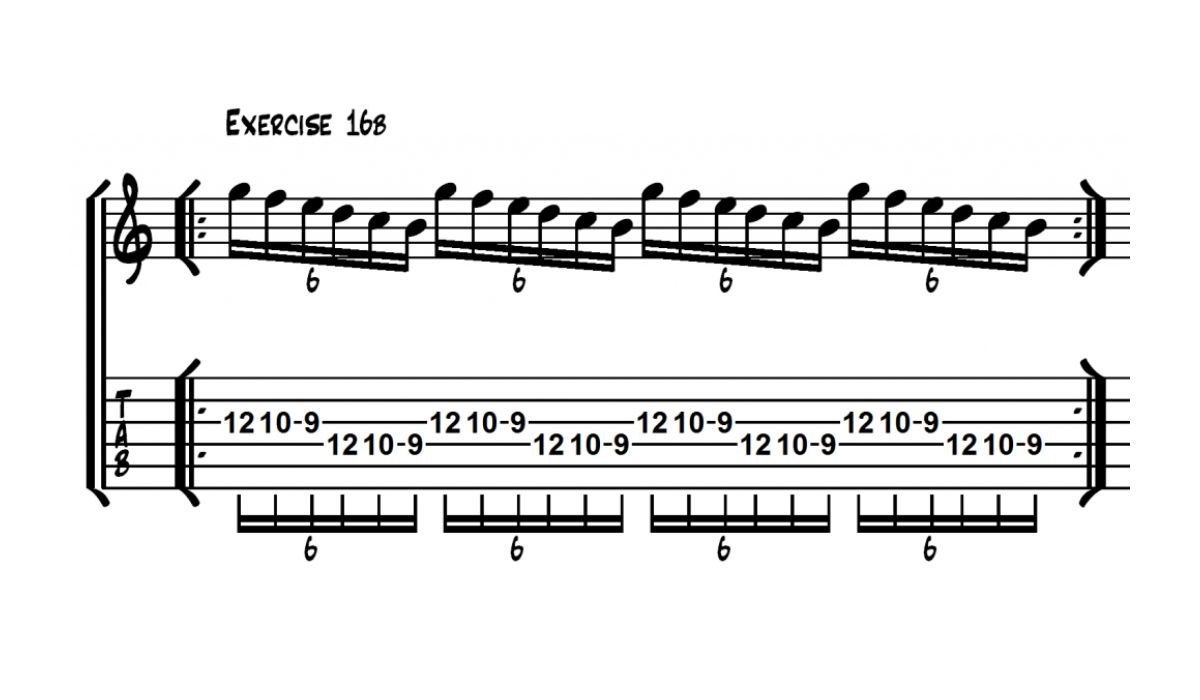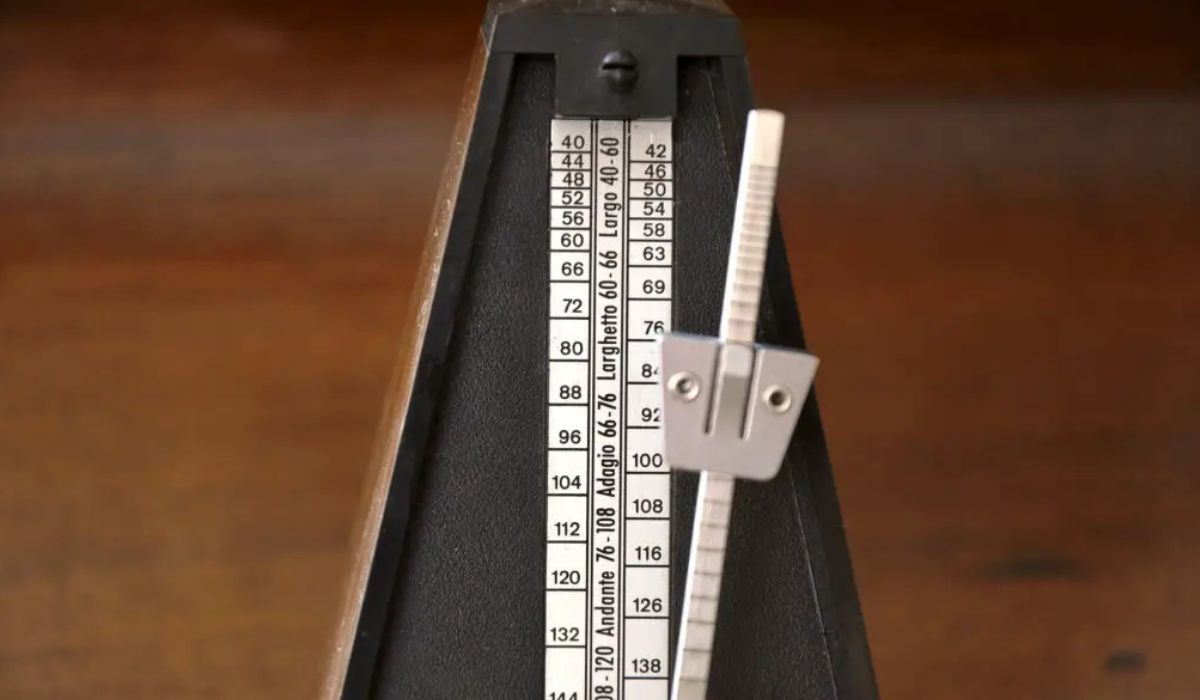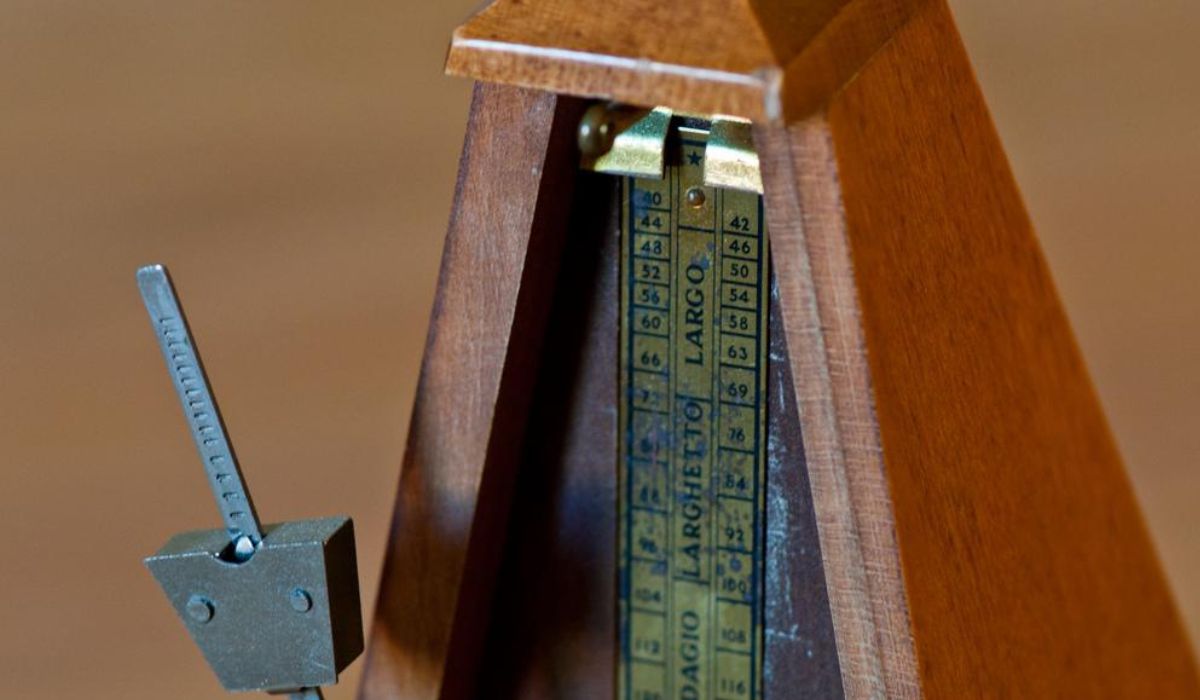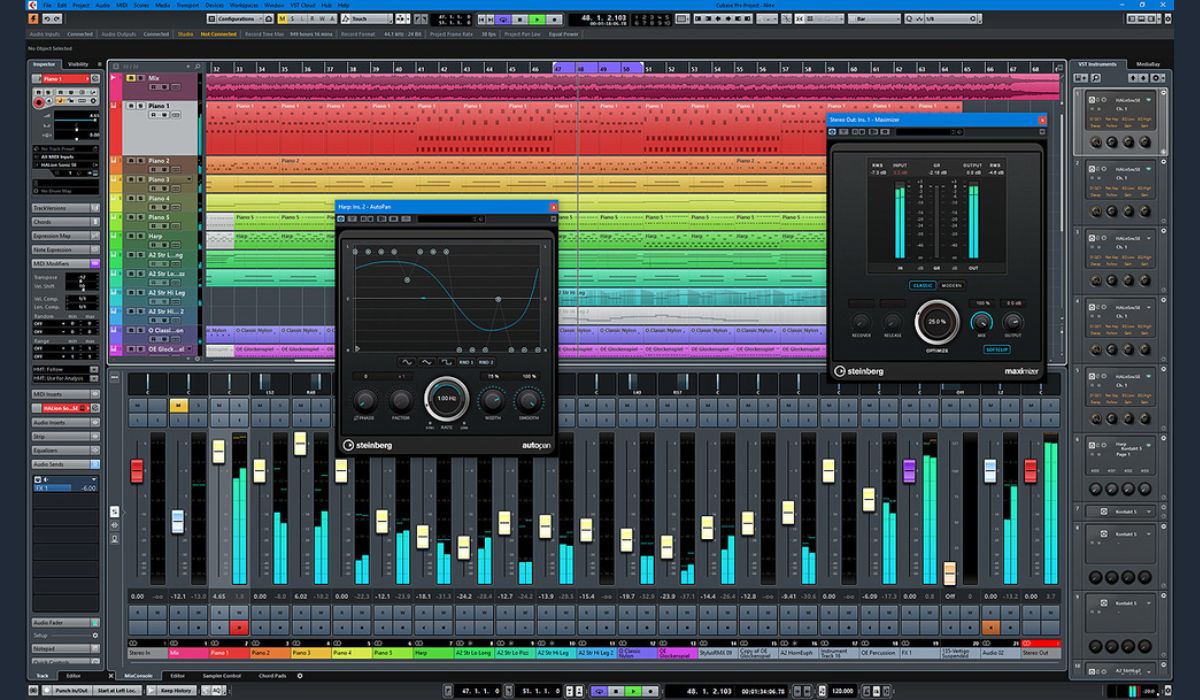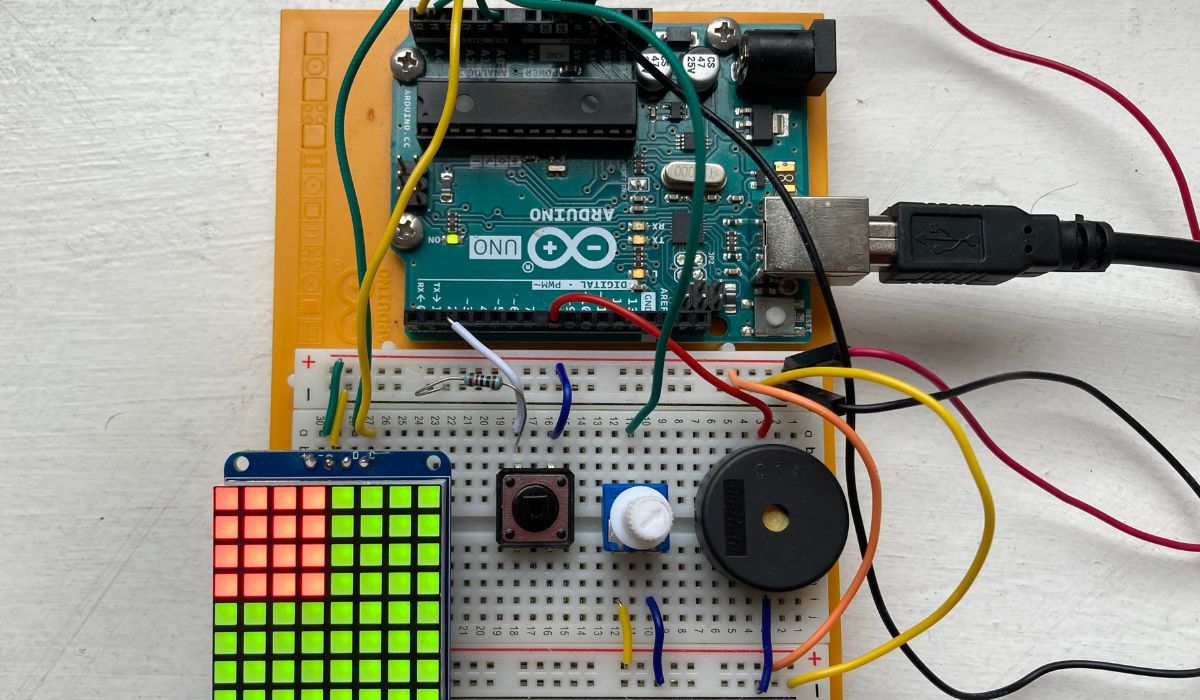Home>Production & Technology>Metronome>How To Play With Metronome


Metronome
How To Play With Metronome
Modified: January 28, 2024
Learn how to play music with a metronome and improve your timing and rhythm. Step-by-step guide to incorporate the metronome into your practice sessions.
(Many of the links in this article redirect to a specific reviewed product. Your purchase of these products through affiliate links helps to generate commission for AudioLover.com, at no extra cost. Learn more)
Table of Contents
Introduction
Welcome to the world of metronomes! Whether you are a beginner musician or an experienced player, incorporating a metronome into your practice routine can immensely benefit your musical journey. A metronome is a device that produces regular beats or clicks at a specific tempo, helping you maintain a steady rhythm and improve your timing skills.
Playing with a metronome can seem intimidating at first, but with the right approach and practice, it becomes an invaluable tool to enhance your playing ability. In this article, we will explore the various benefits of using a metronome, discuss how to get started with one, and provide tips and techniques to make the most out of your metronome practice sessions.
Why should you use a metronome? The answer is simple: consistency and precision. By aligning your playing with the constant beat produced by the metronome, you develop a stronger sense of timing, improve your rhythmic accuracy, and cultivate a solid foundation for your musicality. Whether you play the guitar, piano, drums, or any other instrument, practicing with a metronome will help you develop the essential skill of playing in time, which is crucial for ensemble playing and performance.
Additionally, playing with a metronome can provide a sense of discipline and structure to your practice sessions. It acts as a musical guide, keeping you focused and accountable for maintaining a consistent tempo. As you progress, you can also use the metronome to challenge yourself by gradually increasing the tempo, pushing your technical abilities and pushing boundaries.
In the following sections, we will delve into the specifics of how to use a metronome effectively, from setting the tempo to practicing different musical elements. So, grab your instrument, turn on your metronome, and let’s dive into the wonderful world of metronome-assisted practice!
Benefits of Using a Metronome
Using a metronome during your practice sessions offers numerous benefits that can significantly enhance your musical abilities. Let’s take a closer look at some of the key advantages:
- Improves timing and rhythm: One of the primary benefits of practicing with a metronome is the development of precise timing and a solid sense of rhythm. When you play along with a consistent beat, it helps you internalize the pulse and groove of the music, making your playing more accurate and synchronized.
- Enhances technique: Playing with a metronome forces you to play with more control and precision. It exposes any inconsistencies or technical flaws in your playing, allowing you to make necessary adjustments and improve your overall technique.
- Develops a strong sense of pulse: A reliable pulse is crucial in music, especially when playing with other musicians. Regular practice with a metronome helps you develop a strong internal pulse, making it easier to play in time and stay connected to the musical rhythm.
- Builds endurance: Practicing with a metronome can also improve your endurance as a musician. By gradually increasing the tempo over time, you challenge yourself to play faster and maintain accuracy, thereby building strength and stamina in your playing.
- Aids in memorization: When learning a new piece of music, practicing with a metronome can assist with memorization. The consistent beat acts as a reliable reference point, helping you internalize the timing and structure of the piece more effectively.
- Prepares for performance: Using a metronome during practice sessions can help prepare you for live performances, where maintaining a steady tempo is crucial. By practicing with a metronome, you develop the ability to play confidently and consistently, regardless of nerves or distractions.
These benefits make the metronome an essential tool for musicians of all levels. Whether you are a beginner looking to establish a solid foundation or an advanced player striving for greater precision, incorporating a metronome into your practice routine can significantly enhance your musical growth.
Now that we’ve explored the benefits of using a metronome, let’s move on to understanding how to get started with one and make the most out of your practice sessions.
Getting Started with a Metronome
When starting with a metronome, it’s important to familiarize yourself with the basic functions and features of the device. Here’s a step-by-step guide to help you get started:
- Choose the right metronome: There are various types of metronomes available, including physical devices, software applications, and online options. Choose a metronome that suits your preferences and needs, whether it’s a traditional mechanical metronome or a digital version with advanced features.
- Understand the controls: Familiarize yourself with the controls and settings of your chosen metronome. Learn how to adjust the tempo, select different time signatures, and control other important features such as accents or subdivision options.
- Start with a slow tempo: Begin by setting the metronome to a slow tempo. This allows you to focus on playing in time and developing a solid sense of rhythm. As you become more comfortable, you can gradually increase the tempo to challenge yourself.
- Choose a suitable time signature: Select a time signature that matches the piece you are practicing or the exercise you are working on. Common time signatures include 4/4, 3/4, and 6/8, but there are many others to explore depending on the musical style and genre.
- Listen and internalize the beat: Before playing along with the metronome, take a moment to listen to the beat and internalize its pulse. This helps you establish a connection with the metronome and better synchronize your playing with the rhythm.
- Practice simple exercises: Begin with simple exercises, such as playing scales or single-note patterns, while following the metronome’s beat. Focus on playing each note precisely in time with the metronome, paying attention to accents and dynamics as required.
- Gradually increase the tempo: As you gain confidence and accuracy, gradually increase the tempo on the metronome. Start with small increments, and only move on to faster tempos once you feel comfortable and in control.
- Experiment with different subdivisions: Many metronomes offer the option to subdivide the beat into smaller units. Experiment with different subdivisions, such as eighth notes or sixteenth notes, to improve your rhythmic precision and agility.
Remember, consistency is key when practicing with a metronome. Make it a regular part of your practice routine and gradually challenge yourself with higher tempos and more complex musical passages. With time and dedication, practicing with a metronome will greatly improve your timing, rhythm, and overall musicality.
In the next section, we will explore techniques for practicing rhythm with a metronome.
Setting the Tempo
Setting the tempo on your metronome is a crucial step in using it effectively. The tempo refers to the speed at which the metronome produces beats or clicks per minute (BPM). Here are some tips for setting the tempo:
- Start slow: When you first begin practicing with a metronome, it’s best to start with a slow tempo. This allows you to focus on playing in time and maintaining a steady rhythm. Starting slow also helps build a strong foundation and accuracy in your playing.
- Use a reference recording: If you’re learning a new piece of music or a song, listen to a recording first to get a sense of the desired tempo. Then, set your metronome to match that tempo. This helps you develop a sense of the appropriate speed and feel of the music.
- Experiment with different speeds: It’s important to explore different tempos to challenge yourself and broaden your skills. Practice at various speeds – slower for precision and control, faster for building speed and agility. Gradually increase the tempo as you become more comfortable.
- Consider the musical style: Different musical styles have different tempo characteristics. For example, a brisk tempo might be suitable for an up-tempo jazz piece, while a slower tempo might be appropriate for a classical adagio. Adjust the tempo on your metronome to match the stylistic requirements of the music you’re playing.
- Adjust for difficulty level: As you work on challenging passages or exercises, it may be necessary to adjust the tempo to a slower speed to ensure accuracy and proper technique. Take your time to master difficult sections before gradually increasing the tempo.
- Mark tempos in your sheet music: To help you remember the ideal tempo for specific pieces or passages, consider marking the tempo markings in your sheet music. This serves as a helpful reminder when you revisit the piece later.
Remember, setting the tempo is a personal process and can vary depending on the piece, your skill level, and musical intent. Use the metronome as a tool to guide and challenge you, enabling you to develop a sense of time and rhythm that enhances your musicality.
In the next section, we will explore techniques for practicing rhythm with a metronome.
Practicing Rhythm with a Metronome
One of the fundamental purposes of using a metronome is to develop a sense of rhythm and improve your timing. Practicing various rhythm exercises with a metronome can greatly enhance your rhythmic skills. Here are some techniques to help you practice rhythm with a metronome:
- Simple subdivisions: Start by setting the metronome to a slow tempo and practice playing simple subdivisions, such as quarter notes or eighth notes, in time with the beat. Focus on landing precisely on the metronome click and maintaining a steady rhythm.
- Syncopation exercises: Experiment with syncopated rhythms by accenting off-beats or playing on the upbeats. This challenges your ability to stay in sync with the metronome while emphasizing different rhythmic patterns.
- Swing rhythms: If you’re playing jazz or other swing-based genres, set the metronome to a swinging feel and practice swinging eighth notes or triplets. Pay attention to the swing ratio and strive for a balanced and flowing rhythm.
- Polygon rhythms: For advanced rhythmic practice, explore complex rhythms such as quintuplets, septuplets, or other irregular subdivisions. Set the metronome to a slower tempo and gradually increase the speed as you become more comfortable.
- Rhythm variations: Choose a simple musical phrase or exercise and experiment with different rhythmic variations. For example, play the same melody with different rhythmic subdivisions or accents. This helps expand your rhythmic vocabulary and creativity.
- Rhythm and dynamics: Practice playing with dynamic variations while staying in time with the metronome. Explore crescendos, decrescendos, and other dynamic markings to enhance your sense of expression and rhythmic control.
- Interplay with the metronome: Once you’re comfortable playing along with the metronome, try adding some musical improvisation or create call-and-response patterns between your playing and the metronome. This fosters a sense of musical conversation and strengthens your rhythmic flexibility.
When practicing rhythm with a metronome, it’s important to remember that precision and accuracy are key. Start with slower tempos and gradually increase the speed as you gain confidence. Focus on maintaining a consistent pulse, staying in sync with the metronome, and internalizing the rhythm to create a strong sense of groove.
In the next section, we will discuss how to incorporate the metronome into practicing scales and exercises.
Playing Scales and Exercises with a Metronome
A metronome is an invaluable tool for practicing scales and exercises, as it helps you develop speed, accuracy, and rhythmic precision. Here are some techniques for incorporating the metronome into your scale and exercise practice:
- Start slow and gradually increase the tempo: Begin by setting the metronome to a slow tempo that allows you to play the scale or exercise comfortably and accurately. As you become more proficient, gradually increase the speed on the metronome to challenge yourself and improve your technique.
- Focus on evenness and accuracy: Pay attention to playing each note evenly and accurately in time with the metronome. Use the metronome as a guide to ensure that your rhythm and timing are consistent throughout the scale or exercise.
- Practice different rhythmic variations: Experiment with playing scales and exercises using different rhythmic patterns. Start by playing the scale or exercise in a straightforward manner, then try incorporating different rhythmic subdivisions, accents, or articulations. This helps to improve your rhythmic flexibility and musicality.
- Work on speed and synchronization: If you’re aiming to increase speed, set the metronome to a tempo slightly faster than your comfort zone. Gradually work on playing the scale or exercise at that tempo while maintaining accuracy and synchronization with the metronome beat. Slowly increase the tempo as you gain proficiency.
- Use the metronome for timing exercises: The metronome is a great tool for practicing rhythmic timing exercises. For example, you can set the metronome to a slow tempo and practice playing groups of notes in sync with the beat. This helps improve your sense of timing and coordination.
- Combine metronome practice with other techniques: While using the metronome, you can also incorporate other techniques such as alternate picking, string skipping, or scale patterns. This enhances your technical skills while maintaining a solid sense of rhythm with the metronome.
- Record and assess your progress: Record yourself playing scales or exercises with the metronome, and then listen back to assess your timing, accuracy, and overall performance. This allows you to identify areas that need improvement and track your progress over time.
By incorporating the metronome into your scale and exercise practice, you develop precise timing, rhythmic accuracy, and technical proficiency. Remember to start slow, focus on evenness and accuracy, and gradually increase the tempo as you progress. Regular practice with the metronome will yield significant improvements in your playing.
In the next section, we will discuss how to integrate the metronome into playing songs and pieces.
Incorporating the Metronome into Songs
Besides practicing scales and exercises, incorporating the metronome into your songs and pieces can greatly enhance your sense of timing, groove, and overall performance. Here are some techniques for effectively integrating the metronome into your song practice:
- Identify the tempo of the song: Before you start playing a song with the metronome, determine the tempo of the piece. You can do this by listening to a recording or using a metronome app that provides tempo detection. Set the metronome to match the tempo of the song.
- Focus on the rhythm: As you play the song with the metronome, pay close attention to the rhythm. Use the metronome as a guide to ensure that you’re playing in time and staying synchronized with the beat. This helps you maintain a steady pulse and groove throughout the song.
- Work on difficult passages: Identify any challenging sections or passages in the song and practice them with the metronome. Set the metronome to a slower tempo if necessary, and gradually increase the speed as you become more comfortable. This allows you to develop accuracy and control in the challenging parts of the song.
- Experiment with different subdivisions and accents: Try playing the song with different rhythmic subdivisions or adding accents to specific beats or notes. This can add variety and musicality to your performance while still maintaining a strong connection with the metronome’s beat.
- Practice transitions and tempo changes: Songs often have tempo changes or sections with varying speeds. Use the metronome to practice smooth transitions between different tempos and execute tempo changes with precision. This helps you navigate through the song effortlessly and maintain a consistent rhythm.
- Record your performances: Record yourself playing the song with the metronome and listen back to your performance. Pay attention to the timing, groove, and overall synchronization with the metronome. This allows you to identify any areas that need improvement and refine your performance.
- Play along with recordings: Once you feel comfortable playing a song with the metronome, try playing along with a recording of the song. This helps you develop your sense of playing in an ensemble and ensures that you’re staying in time with the original recording or backing track.
By incorporating the metronome into your song practice, you develop a strong sense of timing, rhythm, and overall musicality. The metronome acts as a reliable companion, helping you stay on track and deliver a polished performance. Practice with the metronome regularly, and you’ll notice significant improvements in your ability to play songs with precision and confidence.
In the next section, we will discuss some tips for effective metronome practice.
Tips for Effective Metronome Practice
To make the most out of your metronome practice sessions, here are some helpful tips to keep in mind:
- Start slow and gradually increase the tempo: Begin practicing with a metronome at a slow tempo, focusing on accuracy and precision. As you become comfortable, gradually increase the tempo to challenge yourself and improve your speed.
- Play ahead and behind the beat: Experiment with playing slightly ahead or behind the metronome beat to develop a sense of different rhythmic feels. This helps you understand the flexibility and interpretation within the music.
- Internalize the beat: Instead of solely relying on the audible click, try to internalize the beat of the metronome. This will help you develop a strong sense of timing and become less reliant on external cues.
- Focus on quality, not just speed: While it’s important to work on increasing speed, prioritize playing with quality and accuracy. Playing cleanly and smoothly at a slower tempo will lay a solid foundation for faster playing.
- Use the metronome while practicing other techniques: Incorporate the metronome into various technical exercises, such as scales, arpeggios, and chord progressions. This helps develop precise timing and control in different musical contexts.
- Alternate between playing with and without the metronome: Occasionally practice without the metronome to gauge your own internal sense of timing and rhythm. This helps you become more self-reliant and flexible in your playing.
- Mix up the subdivisions: Utilize different subdivisions, such as quarter notes, eighth notes, and triplets, to improve your rhythmic versatility and synchronization. Practice playing different subdivisions within the context of a single musical phrase.
- Experiment with different time signatures: Explore practicing in various time signatures to expand your rhythmic understanding. This enhances your ability to adapt to different musical styles and genres.
- Record and evaluate your progress: Record your practice sessions with the metronome and listen back to assess your timing, rhythm, and overall performance. This allows you to identify areas that need improvement and track your progress over time.
- Make it musical: Remember that the metronome is a musical tool, not just a mechanical device. Use it to enhance the musicality of your playing, emphasizing dynamics, phrasing, and expression while staying in time.
By following these tips, you can maximize the effectiveness of your metronome practice and develop a strong sense of timing, rhythm, and groove. Remember to approach each practice session with focus, patience, and dedication, allowing yourself to progress and grow as a musician.
In the next section, we will discuss some common mistakes to avoid when using a metronome.
Common Mistakes to Avoid
While practicing with a metronome can be highly beneficial, it’s important to be aware of some common mistakes that musicians may make when using this tool. By avoiding these pitfalls, you can make your metronome practice sessions more effective and rewarding. Here are some common mistakes to watch out for:
- Relying too heavily on the metronome: While the metronome is a valuable tool for developing timing and rhythm, it’s important not to become overly reliant on it. Strive to develop your internal sense of timing and rhythm by occasionally practicing without the metronome.
- Ignoring dynamics and musicality: It’s easy to get caught up in simply playing in time with the metronome without paying attention to dynamics and musical expression. Remember to incorporate dynamics, phrasing, and musical interpretation into your playing, making your performances more engaging and musical.
- Playing mechanically: Playing mechanically, with no variation in articulation or expression, can result in a robotic and lifeless performance. Use the metronome as a guide but strive for a musical interpretation that adds depth and emotion to your playing.
- Ignoring subdivisions: Many musicians tend to focus solely on the downbeat of the metronome, neglecting the importance of subdivisions. Incorporate different subdivisions into your practice sessions to improve your rhythmic accuracy and flexibility.
- Skipping difficult passages: It can be tempting to avoid practicing challenging sections by playing them at a slower tempo or skipping them altogether. Instead, focus on practicing those difficult passages with the metronome at a slow tempo, gradually increasing the speed as you improve.
- Not recording and evaluating progress: Failing to record and evaluate your practice sessions can hinder your progress. Recording allows you to identify areas that need improvement, measure your progress, and make necessary adjustments to enhance your playing.
- Setting the tempo too fast: Setting the metronome to a tempo that is too fast for your current skill level can lead to sloppy playing and a lack of control. Progress gradually and start with a tempo that allows you to maintain accuracy and technique.
- Practicing mindlessly: Engaging in mindless practice, going through the motions without focus or intention, can hinder your progress. Stay fully present and mindful during your metronome practice sessions, giving your full attention to the task at hand.
- Focusing solely on speed: While speed is important, it shouldn’t be the sole focus of your metronome practice. Prioritize accuracy, consistency, and musicality alongside increasing your speed to develop a well-rounded playing style.
- Not experimenting with different styles: Don’t limit yourself to practicing one style or genre exclusively with the metronome. Experiment with different musical styles and tempos to broaden your musical horizons and improve your versatility as a musician.
By avoiding these common mistakes and approaching your metronome practice with intention and mindfulness, you can maximize the benefits and make significant progress in your musical journey.
In the final section, we will conclude our discussion on the importance of incorporating a metronome into your practice routine.
Conclusion
Incorporating a metronome into your practice routine is a game-changer for musicians of all levels. By using this valuable tool, you can develop a strong sense of timing, improve your rhythm, enhance your technical abilities, and elevate your overall playing skills.
Throughout this article, we have explored the various benefits of using a metronome, from improving timing and rhythm to building endurance and preparing for performances. We’ve discussed how to get started with a metronome, including setting the tempo and practicing rhythm exercises. Additionally, we’ve explored techniques for using the metronome with scales, exercises, and actual songs, as well as offered tips for effective metronome practice and highlighted common mistakes to avoid.
Remember, the metronome serves as your musical guide, helping you stay in time, develop precision, and unlock your full potential as a musician. However, it’s important to balance using the metronome with developing your internal sense of rhythm and musical expression. Strive for a balance between playing accurately with the metronome and infusing your playing with dynamics, phrasing, and musicality.
So, whether you’re a beginner embarking on a musical journey or an experienced musician looking to refine your skills, embrace the metronome as your trusty practice companion. Use it regularly, challenge yourself, and be patient with your progress. As you incorporate the metronome into your practice routine, you’ll notice significant improvements in your timing, rhythm, technique, and overall musicality.
Now, grab your instrument, set your metronome, and let the rhythmic journey begin!


